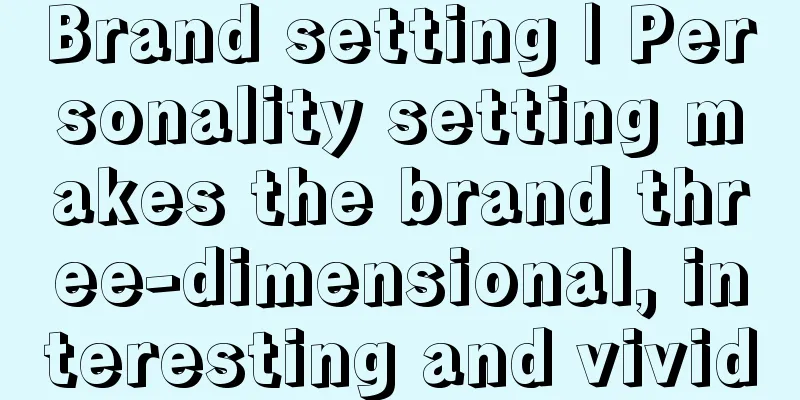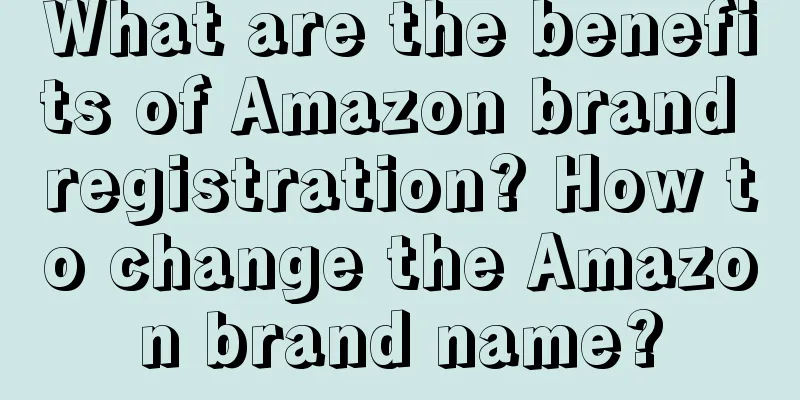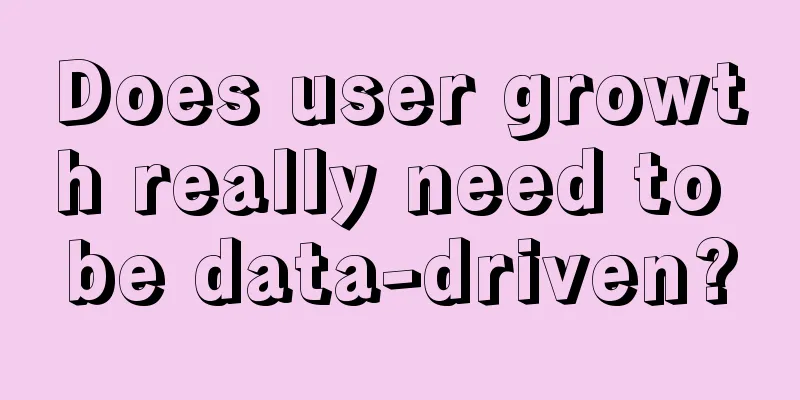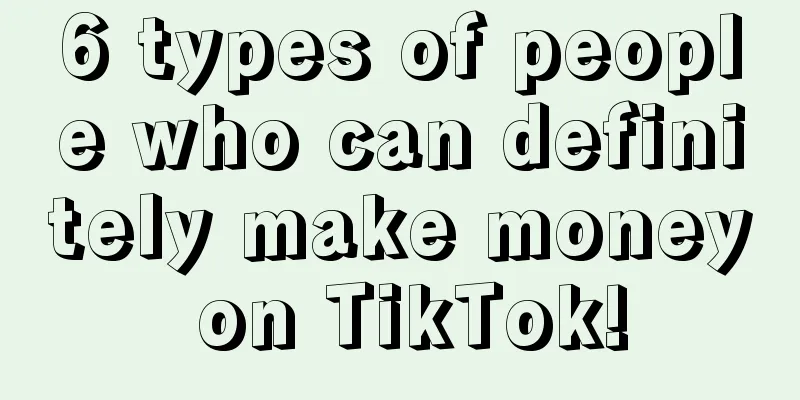Brand setting | Personality setting makes the brand three-dimensional, interesting and vivid

When it comes to personality, I think your first reaction should not be the brand personality, but the collapse of various celebrities’ personalities in the past two years, which is shocking and makes people watch from the front row. Although the endings are mostly regrettable, the "personality" imprinted on the stars is very similar to the "brand personality" we are going to talk about today. Perhaps in today's era, whether it is a celebrity, personal IP, brand, or even ourselves, we all need a personal image. 1. Personal IP requires personalityLet me ask you a question: between Li Jiaqi and Wei Ya, which anchor do you prefer? Who do you spend the most money with? I think a large part of the reason is not who helps fans get more discounts or the product quality is better, but whose personality, way of speaking, and even micro-expressions make you more pleasing to the eye in the live broadcast room and more receptive to his/her sales promotion. These things that make you "pleasing to the eye" are determined by the personality. 2. Stars need personalityWe must have watched quite a few variety shows, especially those that are competitive and ultimately determine the first and second place. Let's recall together, in a competitive variety show, which stars will leave a deep impression on you first? Do you think they are these three categories: very professional, very good-looking, and have outstanding personalities? But the first to break the circle may be a combination of the first two and the third. Because "there is no first in literature and no second in martial arts", the audience wants not only your explosive performance and showy high notes, but also whether you are interesting and have contrast. The same goes for appearance. In the entertainment industry, good looks may only be stunning for a moment in the eyes of the audience. Compared to a beautiful appearance, an interesting soul may be more lasting. This requires celebrities to have distinctive personalities to support it. 3. Brands need peopleStrictly speaking, it is the current brands that need personality, not the original brands. Yes, it seems that before 2016, you probably had not heard of the term brand personality. We all know that brands are born gradually as competition intensifies. In the early stages of competition, the market is in short supply, and as long as brands provide stable product and service quality, they will not be afraid of lack of consumers. Therefore, in the early stages, brands can develop healthily without personality. But in the long run, these brands will easily treat consumers as mere objects of "buying, buying, buying", where they pay money and receive goods, rather than as real users. But as an individual, users naturally like and are more willing to get close to real, interesting, and lively "people", rather than cold customer service and factory machines. This may sound abstract, so let’s take the 2014 Jianbing Guozi as an example. We have all eaten Jianbing. There may be a Jianbing shop near your home that you particularly like. But if you say there is any obvious difference between this shop and the Jianbing shops in other places, it may only be the taste. You may not even remember the brand name or what the store looks like. Every time you just pay for the pancakes, you don’t have any further interaction with it. Because usually pancake shop owners focus on the taste of their products, and there is nothing wrong with that. But in Beijing in 2014, there was a pancake shop that was a little different. It was called Huang Taiji. Not only did the customers know it, but also the bigwigs in the Internet and catering circles and people outside Beijing knew it. Although it has disappeared now, Huang Taiji in those days can be regarded as a model for brand personality building. It not only sells pancakes, but also sells the founder's personality, feelings, and even the personality of its employees. In 2012, he labeled himself as an advertiser, entrepreneur, and opponent of foreign fast food. He knew that his store was surrounded by programmers, designers and entrepreneurs from IT startups, so he wrote "Pancakes Change the World" and "Hamburgers and French Fries Are Paper Tigers" in his store. He even measured the thickness of a pancake to make fun of Apple, using technical terms and Apple-style copywriting to gain recognition from the Internet and IT circles. He not only created a persona for himself, but also for the pancake chef in the store. He took photos, made posters, put them in the store, and wrote the story of his pancake making, wanting customers to believe that your pancakes are made by this chef. Here is also the story behind him. In those years, when it came to pancakes, no brand appeal could surpass He Chang’s Huang Taiji. He did not treat the people who came to eat pancakes as diners who just came to enjoy the taste and the product, but as living users. He also integrated his own personality into Huang Taiji and chatted with users. 1. The example of Huang Taiji is to illustrate the importance of two aspects of brand personality(1) Personality makes the brand more easily recognized When the market is oversupplied, competition between brands intensifies. Good products alone are no longer enough to attract consumers. Only by "differentiating" yourself as much as possible and communicating with users in a human way can you gain better recognition from users. (2) Personality can add charm to a brand Help brands communicate with users, make users feel that you are different, and when they choose you, they also show their own differences. Only by establishing a personality can the brand have a unified attitude and way of expression to communicate with users, and ultimately form a consistent brand image. Having said so much, how do we establish a brand personality? In fact, we do this every day, and every celebrity does it too. 2. Examine yourself and summarize your impressions and labelsLet’s recall, how did you find like-minded colleagues and become friends in a new company? At work, we can rely on professional skills to obtain a stable position and colleagues who work with you. This is equivalent to colleagues being "users" who use the functions of your product. You and your colleagues are just work relationships, so how can you become friends? It must be that when you cooperated with him, both of you showed your own personality, values, and understanding of work. Even when you talked about where you usually go on Saturdays and Sundays, you were surprised to find that you have the same hobbies and favorite stores and brands. After a while, they became friends. Because we attract friends and partners based on personality, values, common hobbies and lifestyles, etc. When you become friends, you are actually becoming each other's "fans" rather than just users. Speaking of this, if you are the founder of a brand and are looking to establish a personality for your brand, you might as well ask your former colleagues and friends what impressions they have of you? Summarizing these impression labels often results in you creating the personality of the brand yourself. 3. Extract brand personality from the founder’s genesLet me give you an example of a client I met, an emerging sleep brand. They discovered that traditional home textile brands had many user pain points. For example, latex pillows cannot be exposed to the sun or washed, and over time they turn yellow inside and accumulate sweat stains and bacteria. In addition, he also found that there are many bugs when people sleep on electric blankets in winter. In addition to the bugs he saw, he also likes to invite users to have a rant, and he is very excited about any measures that can be implemented to improve the sleep quality of users. He is a madman when it comes to developing new products, exploring user pain points, and solving product problems. In addition, he also does his own brand broadcast, explaining the product to everyone passionately as the founder, with a slight accent. Users are willing to believe him and think that the brand is sincere and attentive to the product. From this description, you can at least extract words such as: user thinking, innovative spirit, enthusiasm, sincerity, simplicity, etc. These were actually the key tags for the brand personality when we were doing this project. But unfortunately, apart from the users who have listened to him in the live broadcast room and can feel his personality, the language, vision, content and other aspects of the brand itself are out of touch with this personality. But don’t worry, this entire brand setting course is to help you unify and organize what the brand wants to convey. When we extract the personality label from the founder's genes and brand story, does that mean the personality design is complete? It is not complete. Since it is a design, there are parts that need to be sublimated and tested. 4. In addition to setting its own label, brand personality also needs to reflect the user’s ideal lifeTo put it bluntly, the personality labels extracted from the founder and the brand story are more of an internal perspective. Whether or not they fit with the target users also determines whether this personality is sustainable. Otherwise, it becomes a self-satisfaction behavior of the brand and fails to resonate with users. Because when we, as a user, are shopping, the labels and attributes of these products are mostly like looking in a mirror, and in the mirror is our ideal self. It sounds a bit weird, but it's true, take a look. A trendy young man who pursues trendy culture will first purchase brands and products with trendy cultural attributes, such as Supreme and skateboards. He also hopes that his personal image can be established. For example, a young person who pursues environmental protection, naturalism, and minimalist style will choose brands such as Haoping, MUJI, and FRETAG. The collaborations between brands often have some similarities in personality labels, so that the user circles they serve overlap, such as the collaboration between HEYTEA and PIDAN. Therefore, we need to list the target users’ lifestyles, values, hobbies, favorite brands, etc. in as much detail as possible, so as to combine them with the labels extracted from the founder’s genes and brand stories to form a complete brand persona. 4. Misunderstandings about personal settings often occur in the customers we serve1. Personality is not differentiated by degreeThis is just like when we make friends, some people like introverts, some people like extroverts, both are good. Just because users are diverse, brand personality should be the same. Not all brands need to be very active and have a strong attitude to be remembered. There are many brands that are like craftsmen, who have been doing one thing seriously, attentively and quietly for many years, and they are also very charming, such as the Japanese God of Sushi. 2. Is it necessary to design a set of cartoon characters when creating a brand personality?The answer is no. Cartoon characters can help better humanize a brand, but they are not necessary, nor are they a necessary choice for a brand to become an IP. Whether your image can be established and remembered by users depends on what the brand does, your words and deeds, and whether the content and activities you continuously produce are consistent with your personality, not on whether you have a cartoon image. The fragrance brand Guanxia has no cartoon characters, but that doesn’t affect your understanding of its personality. There are many other brands that are the same. In other words, if you create a cartoon character but cannot keep up with the subsequent operations, it will be a waste of time. For most new brands, if the founders are not from content and design background, I do not recommend designing cartoon characters, because you will need to pay a lot for the liveliness and content of this cartoon character later, and this may not be something you are good at. But if the team is good at operating cartoon characters, they can certainly project the brand personality onto them, such as the well-known Jiang Xiaobai and Xiaobai Xinliruan. There is another Japanese tofu brand that I like very much, Nanzen Tofu. In our usual impression, tofu is soft, but the founder used the character setting of "masculinity" on tofu, and the soft tofu became a symbol of masculinity. This approach immediately stood out from the many Japanese tofu brands and stood at the forefront of fashion trends. Many Japanese who could not buy men's tofu would also make reservations to buy it because they wanted this kind of cool feeling. At the same time, the founder made innovations in raw materials, craftsmanship and taste around the theme of "masculine charm". In just a few years, it quickly became popular, and a piece of tofu became a big business worth 5 billion yen. 3. Can a brand’s personality change?I think there is no unchanging brand in this era. The earliest advertisement of Coca-Cola was about the pleasant taste , then it became about enjoying happiness , and now it is about sharing happiness with everyone. The core theme has not changed, but it is slowly changing itself according to changes in the market and social ideology. Regardless of the brand story, concept, values or personality, what should remain unchanged is the core, or the original intention and purpose, which is difficult to change or adjust. For example, the original personality of a brand may be very simple and honest, but it may be humorous occasionally to create a contrast, which users may find interesting and unexpected, but the core remains unchanged. I think there is no problem with this kind of change. Author: Shaokang loves brain burning Source: Shaokang Blake (ID: shaokang92) |
<<: 8 favorite sentences in January
>>: 80 professional terms you must know for short video/live broadcast operations
Recommend
Metaverse Marketing, PepsiCo Has Mastered It
PepsiCo, which is more than 100 years old, has tak...
Can I apply again if I am rejected by Meikeduo? How can I strengthen my account security?
If you are doing e-commerce, you can generally cho...
Why did a bunch of ordinary bananas become an Internet sensation?
As a common fruit, it has now become a social medi...
E-commerce platforms have launched "automatic price tracking" one after another, forcing hundreds of millions of merchants to hurry up
The new strategy of e-commerce platforms - the aut...
What data does Amazon usually refer to when it talks about traffic?
On Amazon, we often talk about whether the store’s...
Luckin Coffee and Kudi, hovering around 9.9
This article analyzes the low-price strategy of th...
Which countries sell well on Amazon Europe? What products are suitable?
There are relatively fewer sellers on Amazon Europ...
What are the tips for ranking high on Alibaba International Station? What is the basis for ranking?
Alibaba has an international site that serves coun...
When promoting e-commerce on Douyin, it is essential to have a shelf market
In Douyin e-commerce, the importance of shelf fiel...
Who is driving the popularity of Zibo barbecue?
Zibo barbecue has become a new top food in the foo...
10 pitfalls that ordinary people will fall into when starting an e-commerce business
Based on personal experience, the author of this a...
What do you think about the "common prosperity" that Bilibili is about to give to UP masters?
B station’s incentive plan has been adjusted. This...
What is a normal conversion rate for new products on Amazon? What are the requirements?
After the cross-border e-commerce Amazon launched ...
This store has been popular for a year because of the water bowl at the door! How do Starbucks and McDonald's create a "pet traffic password"?
Pet marketing is not exclusive to pet brands, but ...
Summer is coming, how can brands play April marketing?
April is coming soon, and the April hot marketing ...









